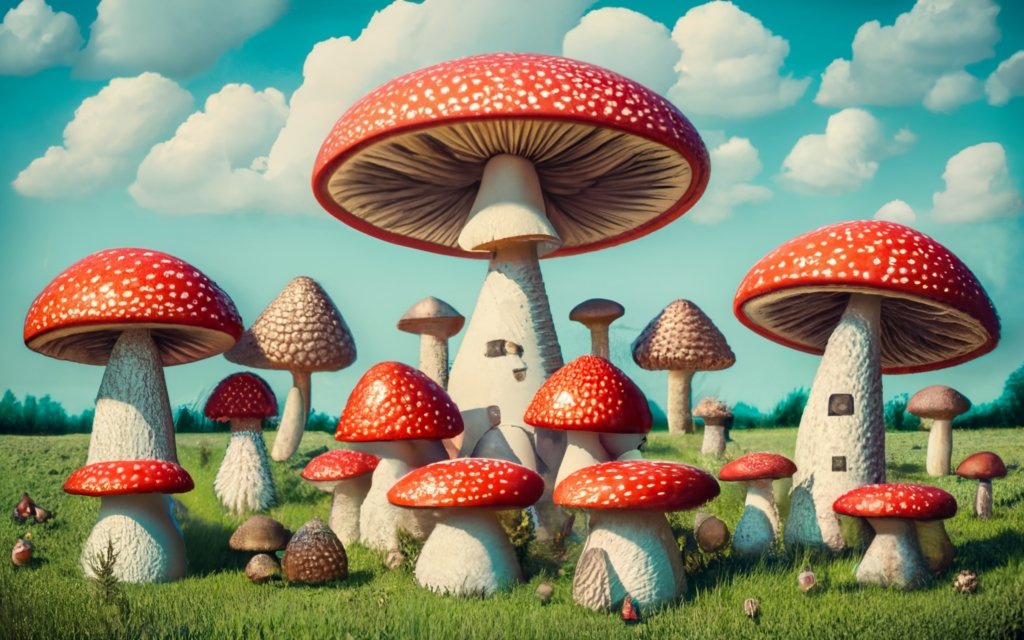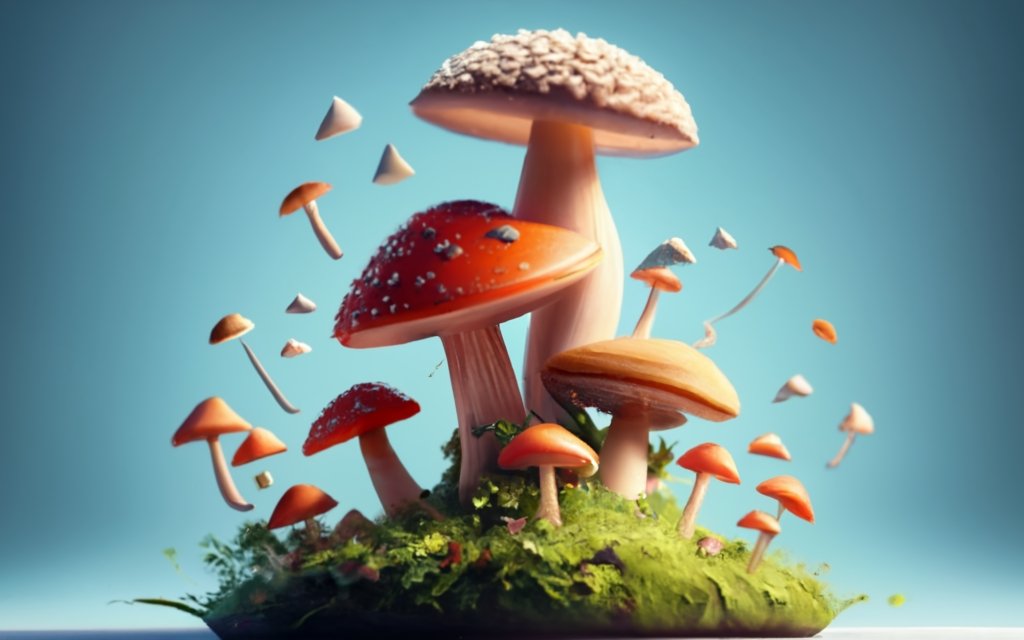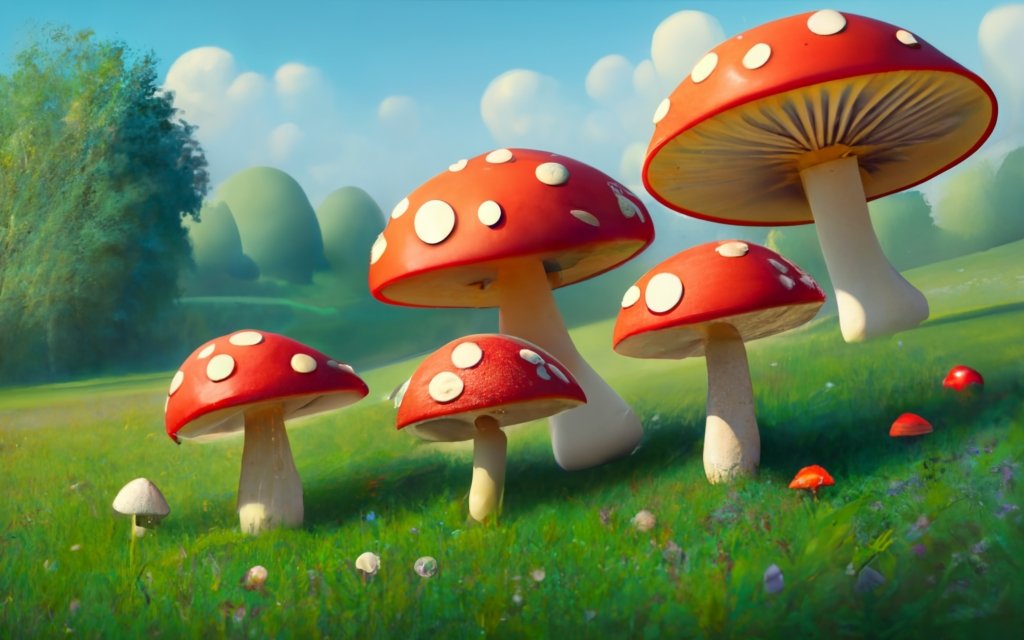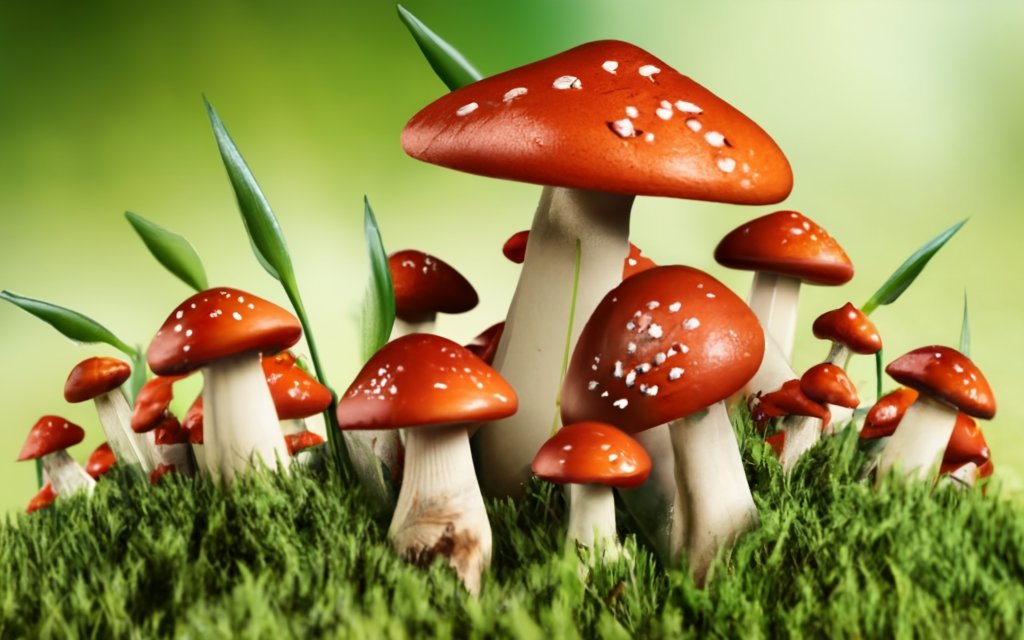Tired of mushrooms popping up and ruining your beautiful lawn? Bleach provides an easy, affordable way to get rid of fungal growth for good. This complete guide covers everything from smart application techniques to what results you can expect. Arm yourself with knowledge and take back control of your yard.
Why Do Mushrooms Grow in Lawns and How to Prevent Them
That familiar sight of mushrooms popping up sporadically in your lawn can be frustrating. But understanding a bit about fungal growth can help prevent mushrooms from taking over your grass.
Mushrooms in lawns form due to a complex interaction of factors that create the perfect environment for fungal growth:
Damp, Shady Conditions
Mushrooms thrive in damp, shaded areas where grass grows poorly. This includes under trees, along fences or garden beds, and in other parts of the yard that get little sun. Without sufficient sunlight to grow thick and strong, grass in these areas becomes thin and stressed. This allows mushrooms an opportunity to move in.
Thatch Buildup
Thatch is a thick layer of dead grass stems and roots that accumulates on the soil surface. Too much thatch prevents water, air, and nutrients from reaching the soil and grass roots. It also provides the ideal shelter and food source for mushroom growth.
Poor Drainage
Compacted or heavy clay soil prevents proper drainage, leading to pooling and soggy areas. Saturated soil lacks oxygen, which limits healthy grass growth but encourages fungal colonization. Mushrooms flourish in the wet conditions.
Unbalanced pH
Most grasses prefer neutral or slightly acidic soil with a pH between 6.0-7.0. But certain fungal species favor more alkaline conditions. If your lawn’s pH drifts above 7.0, it can trigger mushroom growth.
Excess Fertilization
Heavy fertilization stimulates thatch buildup by causing grass to grow rapidly. The extra nitrogen also benefits fungal colonies. Over-fertilized lawns are prone to mushroom outbreaks.

Stopping Mushrooms at the Roots
The best defense is a good offense when it comes to preventing fungal growth. By proactively improving overall lawn health, you can halt mushrooms before they start:
Increase Sunlight Exposure
Prune overhanging tree branches and shrubs to open up closed-canopy areas. For sections in permanent shade, reseed with a shade-tolerant grass or use shade-loving groundcovers instead of turfgrass.
Improve Drainage
Aerate compacted clay or loam soils to allow better water infiltration. Install drainage channels or French drains to divert excess moisture. Adjust irrigation schedules to water early in the day; avoid frequent shallow watering.
Dethatch and Aerate
Thatch accumulation should be less than 1/2 inch deep. Rake vigorously and rent a power dethatcher annually to remove excess thatch buildup. Core aeration also helps by punching holes to increase soil oxygen.
pH Modification
Test soil pH yearly and amend as needed to maintain the ideal slightly acidic pH range. Sulfur lowers pH in alkaline lawns while lime raises pH in very acidic soil.
Adjust Fertilizer Program
Follow a balanced fertilization schedule based on soil tests, reducing nitrogen in favor of phosphorus and potassium. Slow-release organic fertilizers are preferable to soluble chemical types.
With some preventative care, you can keep those pesky mushrooms from popping up everywhere and create the healthy lawn environment grass needs to thrive. But if you do see some fungal growth, don’t worry – we’ve got tips on getting rid of mushrooms safely and effectively coming up next.
Is Bleach Safe and Effective for Killing Lawn Mushrooms?
Bleach is a popular DIY treatment for getting rid of fungal growth in lawns. The active ingredient, sodium hypochlorite, is effective at destroying mushrooms. But bleach also carries risks if not used properly. Understanding both the benefits and potential downsides will help you decide if bleach is the right solution for your yard.
How Bleach Kills Mushrooms
Bleach works quickly to rupture cell walls and deactivate proteins in fungus. This stops mushroom growth and prevents spore dispersal.
Destroys Cell Walls and Proteins
The sodium hypochlorite in bleach oxidizes and disrupts critical structural components in fungal cells. It breaks down cell walls, membranes, and internal proteins. This leads to complete cellular breakdown.
Prevents Spore Spread
Bleaching also deactivates mushroom spores, the reproductive units that allow rapid fungal spread. By preventing spore dispersal, bleach helps halt the mushroom lifecycle.
Potential Risks of Using Bleach on Lawns
While effective, bleach does carry some cautions. The same compounds that destroy fungi can also potentially damage other living things.
Toxic if Ingested
Concentrated bleach solution is very caustic if swallowed by pets or children. Always keep bleach products locked away and avoid overspray near walkways.
Can Harm Grass and Plants
Bleach can burn and discolor nearby grass or ornamentals if it drifts away from just the mushrooms. Use a spray bottle or shield vegetation when spot treating.
Corrosive to Skin and Eyes
Bleach can cause skin and eye irritation with direct contact. Always wear gloves, long sleeves, and eye protection when handling. Avoid breathing vapors.

When to Call a Professional vs. DIY Bleach
For minor outbreaks, spot treating mushrooms with bleach is usually safe for DIY. But for severe or recurring growth, a professional fungicide treatment may be needed.
Large or Stubborn Growth – Call a Pro
If mushrooms cover a large portion of your lawn or persist after DIY attempts, the underlying fungal network may be extensive. Professionals have commercial-grade fungicides and application equipment to eradicate severe fungus.
Small Areas – DIY Bleach is Effective
Spot treating a few scattered mushrooms is well-suited for careful DIY bleach application. Just be sure to take proper safety precautions.
Bleach can be powerful medicine for lawn mushrooms but also requires care in handling. Keep these pros and cons in mind when deciding whether to take matters into your own hands or call in a pro.
How to Apply Bleach to Kill Lawn Mushrooms
Using the proper bleach solution and application techniques is key to safely and effectively removing mushrooms from your lawn. Follow these tips for DIY bleaching.
Choose the Right Bleach Product and Concentration
Not all bleaches are created equal when it comes to killing fungus. Pick an effective product and mix it correctly.
Use 5-10% Chlorine Household Bleach
Look for an unscented bleach containing 8-10% sodium hypochlorite. The optimal concentration for treating mushrooms is:
- 5% bleach to water for spot treating scattered growth
- 10% bleach to water for large or dense outbreaks
Avoid Thickened or Scented Formulas
Bleaches with thickeners like xanthan gum don’t spread as evenly. And added fragrances can be harsh on grass and plants. Stick to plain bleach.
Mix Fresh Solution for Each Application
Bleach begins degrading once mixed with water. Prepare only what you need per use and discard any leftovers.
Spot Treating Individual Mushrooms
A spray bottle allows careful application to individual mushrooms.
Use a Spray Bottle for Precision
Spot treat mushrooms by filling a spray bottle with diluted bleach solution. Adjust the nozzle to a direct stream setting.
Spray Mushrooms and Surrounding Soil
Hold the bottle close and spray each mushroom directly, along with a 3-6 inch radius of surrounding soil to penetrate potential threads.
Leave in Place for 24 Hours
Let the bleached mushrooms sit for a full day before removing the dead growth. This allows the bleach to fully penetrate the organism.
Treating Larger Areas of Growth
For more extensive fungi, a pump sprayer provides wider coverage.
Use a Pump Sprayer for Large Areas
Pump style sprayers allow covering more ground efficiently. Use a fan type nozzle for the best coverage.
Focus on Visible Growth and Nearby Soil
Concentrate on wetting down visible mushroom caps along with a 1 foot perimeter around each one to contact surrounding fungal threads.
Leave in Place 48-72 Hours
Give large treated areas 2-3 days before raking up the dead fungal material. Check for any missed spots and do a follow-up application if needed.
Tips for Safe and Effective Application
Take proper precautions when handling bleach to protect yourself, pets, and other vegetation:
- Wear gloves, long sleeves, closed-toed shoes, and eye protection.
- Avoid spraying near ornamental plants, trees, or desirable grass.
- Apply bleach solutions on a dry, sunny day with low wind.
- Keep pets indoors during application and until treated areas are dry.
- Rinse sprayer hoses and nozzles with clean water when finished.
With the right bleach product and some careful application, you can selectively eliminate lawn mushrooms without harming the surrounding landscape.

What to Expect After Bleaching Mushrooms in Your Lawn
Bleach works quickly to kill visible mushrooms. But completely eliminating the underlying fungus takes more time. And you may notice some temporary discoloration of grass after treatment.
How Long It Takes to See Results
While bleach damages mushrooms right away, allow enough contact time for it to work into the soil.
Mushrooms Turn Black Within Hours
The sodium hypochlorite causes rapid oxidation and decay of the mushroom caps soon after application. They will turn black and appear dead within a few hours.
Complete Kill Takes 24-72 Hours
It takes 1-3 days for the bleach to fully penetrate fungal threads in the soil. Don’t remove dead mushrooms until the full contact time has elapsed.
Repeat Application if Some Regrow
If you notice some mushrooms returning to life in treated areas, do a follow-up spot application to finish them off.
Bleached Spots and Potential Grass Damage
The bleach solution can leave temporary white spots where it contacts grass, and may cause damage if over-applied.
Bleached Circles Where Treated
You may notice lightened circles in the grass encircling where you sprayed mushrooms. This whitening effect is only superficial and the grass will recover.
Can Harm Grass if Overly Concentrated
Strong bleach solutions can damage nearby grass. Use the minimum effective concentration and avoid excessive runoff.
Fades Over Time as Grass Grows
Any grass discoloration or harm from light bleach exposure will grow out in 1-2 mowings. Reseed any dead patches if needed.
Preventing Mushrooms from Returning
Keep up proper lawn care to deny mushrooms an hospitable environment after treatment.
Continue Lawn Care Regimen
Keep fertilizing, aerating, dethatching, and monitoring soil pH to promote thick, healthy turfgrass.
Repeat Bleach Periodically as Needed
Plan on periodic spot treatments to catch any new mushroom colonies when conditions favor fungal growth.
It may take some patience waiting out the full effects of bleaching mushrooms. But your efforts will pay off with a fungus-free lawn.

Natural Alternatives to Killing Lawn Mushrooms with Bleach
If you’re wary of using harsh chemicals like bleach, there are some organic options to try instead for treating lawn fungi. These solutions may take longer to work but are gentler on grass and pets.
Vinegar
The acetic acid in vinegar provides anti-fungal properties without the risks of bleach.
Acetic Acid Kills Fungi
Vinegar contains 5-7% acetic acid, which helps break down mushroom cell walls. It’s not as potent as bleach but still effective.
Safer for Lawns Than Bleach
Even undiluted vinegar causes little to no harm to most grass varieties. And it’s non-toxic to children and pets.
Corn Gluten Meal
This organic fertilizer has natural pre-emergent herbicide effects on mushrooms.
Prevents Mushroom Growth
Corn gluten meal inhibits root formation and development of fungal threads. It stops them from establishing.
Provides Lawn Fertilization
A bonus benefit – corn gluten meal adds a slow release source of nitrogen for improved grass growth as it controls mushrooms.
Salt, Lime, Ammonia
Abundant household items like these have mild anti-fungal properties with some caveats.
Light Scattering Disrupts Growth
The sodium in salt, calcium in lime, and ammonia ions create an inhospitable environment for sensitive fungal cells.
Reapplication Often Needed
These household alternatives work best with repeated applications. And salt may damage grass with overuse.
Vinegar, corn gluten, and other home treatments let you target lawn mushrooms without the risks of chlorine bleach. Just be prepared for more gradual results compared to stronger synthetic fungicides.
FAQ About Using Bleach for Lawn Mushrooms
You probably have lots of questions about the safe and effective use of bleach for controlling lawn fungi. Here are answers to some of the most frequently asked ones.
Is it okay to bleach mushrooms growing in mulch beds?
Yes, you can spot treat mulched landscape beds in the same manner as grass. Just avoid excessive runoff into desired plants. Test a small area first to check for sensitivity. And rinse any bleached mulch to prevent lingering color change.
How often do I need to treat mushrooms with bleach?
Plan on periodic applications as needed during periods of frequent rainfall or over-watering. For severe infestations, treat on a 14-21 day cycle until you get the problem under control. Routine spot treatments 2-4 times per year are also a good preventative.
What precautions should I take when using bleach on my lawn?
Always follow basic safety gear including gloves, eye protection, closed shoes, and long pants/sleeves. Avoid breathing fumes or allowing the solution to contact skin. Keep kids and pets away from treated areas until completely dry. Prevent runoff into gardens and ornamental plants.
Will bleach kill the roots of the mushrooms under the soil?
Bleach will penetrate into the top inch or two of soil to contact buried fungal threads. For severe infestations with deeper colonization, several repeat treatments may be needed to fully eradicate. Aerating prior to bleaching helps the solution infiltrate deeper.
Is there anything I can mix with the bleach to make it more effective?
Never mix bleach with other chemicals like ammonia or acids, which can create toxic gases. Some lawn care pros recommend adding a teaspoon of dish soap per gallon of diluted bleach solution as a surfactant to help it adhere and penetrate mushrooms and soil better.
What should I do if my grass shows damage after bleaching for mushrooms?
If you notice dead brown patches from too much bleach concentration or contact time, reseed any substantial bare spots. Use a high quality grass seed variety well-suited for shade if under trees. Keep the areas continually moist until new grass is established. Avoid walking on sensitive areas while they recover.
Are some types of mushrooms resistant to bleach?
Most common lawn mushroom varieties are effectively treated with sodium hypochlorite bleach. But a few types like fairy ring mushrooms may require repeated applications or professional-grade fungicide. Look for stubborn mushrooms returning within 2-3 weeks and consider switching solutions.
Can bleach stain concrete or wood near the treatment area?
Avoid spraying bleach solution directly on decorative concrete edging, patios, or wood playsets or fences. The sodium hypochlorite can discolor and lighten some materials. Careful application only to mushrooms and immediately surrounding soil reduces the risk of stains.
Bleach can be a useful tool for tackling recurring lawn mushrooms with proper understanding and precautions. Always start with the lowest effective dosage and increase concentration if needed. With smart application and safety measures, you can selectively eliminate fungal growth while protecting the rest of the landscape.
Key Takeaways for Safely and Effectively Using Bleach on Lawn Mushrooms
- Test soil pH and improve drainage to deter fungal growth proactively.
- For spot treating scattered mushrooms, use a 5% bleach-to-water solution in a spray bottle.
- Cover a 1 ft radius around each mushroom to contact threads in the soil.
- Let bleach sit for 24 hours before removing dead mushrooms.
- For larger areas, use a pump sprayer and 10% bleach solution.
- Wait 48-72 hours before raking up treated mushrooms.
- Repeat applications may be needed for severe or persistent growths.
- Wear protective gear and avoid drift onto grass and plants.
- Bleached grass will recover over time – reseed any substantial dead patches.
- Vinegar and corn gluten meal offer organic alternatives for sensitive lawns.
- Call a pro for extensive infestations that resist repeated DIY attempts.
- Be patient and persistent, spot treating as needed to keep mushrooms at bay.
Frequently Asked Questions About Using Bleach for Lawn Mushrooms
Q: How long does it take for bleach to kill mushrooms?
The sodium hypochlorite begins damaging the fungal cells immediately on contact. However, allow at least 24 hours before removing spot treated mushrooms to give the bleach time to fully penetrate. For large treated areas, wait 48-72 hours.
Q: Will bleach kill the mushroom roots in the soil?
Bleach will penetrate into the top inch or two of soil to contact buried fungal threads. For severe infestations with deeper colonization, you may need to do several repeat treatments to fully eradicate. Aerating prior to bleaching helps the solution get deeper into the soil.
Q: Does the type of bleach matter?
Look for an unscented bleach containing 8-10% sodium hypochlorite as the active ingredient. Avoid bleaches with added thickeners, fragrances or cleaners which can harm grass. Make sure it does not contain ammonia.
Q: How often should I treat for mushrooms?
Spot treat on an as-needed basis whenever you notice new mushroom growth during moist conditions favoring fungi. For severe cases, treat every 2-3 weeks until controlled. Plan on periodic applications during the wet spring and fall.
Q: Is it safe for pets?
Avoid letting pets onto treated areas until completely dry. Prevent them from ingesting bleach solution which can be toxic if swallowed. Keep bleach products locked away out of reach.
Q: What ratio of bleach to water should I use?
For spot treating individual mushrooms, a 5% solution (6 ounces bleach per gallon) is effective. For widespread growth, bump up to a 10% solution (12 ounces bleach per gallon).
Q: Can I mix bleach with anything to make it work better?
Never mix bleach with other chemicals, acids, or cleaners as toxic fumes can result. Some pros recommend a teaspoon of dish soap per gallon as a surfactant.
Q: What should I do if my grass shows damage?
Grass should recover from minor lightening in 1-2 mowings. Reseed any dead patches with a quality seed suited for shade if under trees. Keep areas continually moist until established.
Q: Are there natural alternatives to bleach?
Vinegar, corn gluten meal, salt, lime and ammonia can help treat fungi without chemicals. However, these organic options require more frequent reapplication than bleach.